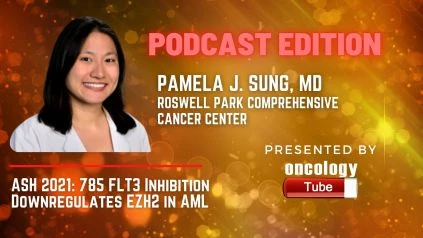Pamela J. Sung, MD from the Department of Medicine, Roswell Park Comprehensive Cancer Center speaks about ASH 2021 Abstract – 785 FLT3 Inhibition Downregulates EZH2 in AML and Promotes Myeloid Differentiation.
Link to Abstract –
https://ash.confex.com/ash/2021/webprogram/Paper147313.html
Fms-like tyrosine kinase 3 (FLT3-ITD) internal tandem duplication mutations are common in AML and are associated with a poor prognosis. In relapsed AML, FLT3 inhibitors (FLT3i) like gilteritinib are effective. In around half of the patients who receive FLT3i, myeloid differentiation of the FLT3-ITD clone occurs. It’s unclear how FLT3i causes this response in a subgroup of people.
Animal models have not previously displayed the FLT3i-induced differentiation response seen in clinical studies. In a mouse Flt3ITD/ITDDnmt3a-/- AML model, we modeled FLT3i-induced differentiation (Meyer et al., Cancer Discovery, 2016). In vitro treatment with FLT3i increased cKIT+ leukemic splenocyte development, as measured by colony morphology in serial re-plating experiments. We implanted CD45.2+ leukemic splenocytes from moribund mice into healthy congenic CD45.1+ animals to assess the differentiation response in vivo. Mice were given either vehicle or gilteritinib for four weeks after engraftment was confirmed two weeks after irradiation. Increased neutrophil and decreased stem/progenitor cell populations were seen in gilteritinib-treated animals, resembling the clinically documented increase in granulocytic differentiation of the FLT3-ITD clone.
The molecular mechanism of FLT3i-induced differentiation was then investigated. To uncover novel FLT3-ITD targets that could be possible mediators of the differentiation response, we conducted a proteomic-based search in a human AML cell line treated with FLT3i. We discovered that the catalytic component of the Polycomb Repressive Complex 2 (PRC2), Enhancer of Zeste Homolog 2 (EZH2), was downregulated (PRC2). In mouse models of MLL-AF9 AML, EZH2 and PRC2 were previously found to be necessary for leukemic maintenance. FLT3i or the EZH1/2 inhibitor (EZH1/2i) were used to treat murine Flt3ITD/ITDDnmt3a-/- cKIT+ leukemic splenocytes. In this model, colony morphology revealed that both induced myeloid differentiation to similar degrees. FLT3-ITD regulates EZH2 to keep leukemia cells in a stem/progenitor cell state, according to our hypothesis. As a result, we investigated FLT3i’s influence on PRC2 in greater depth. Our proteomic findings revealed that FLT3i reduces EZH2 protein levels in FLT3-ITD cell lines and primary human AML within 24 hours of therapy (Figure 1A-B). The mechanism of EZH2 downregulation is complex, involving transcriptional effects as well as a decrease in EZH2 protein half-life, according to our findings. Reduced peaks at the transcription start sites of PRC2 target genes were discovered using ChIP-Seq for H3K27me3 (Figure 1C). At 253 differentially expressed genes, RNA-Seq gene expression patterns of FLT3i- and EZH1/2i-treated human AML cells overlapped (Figure 1D). Both FLT3i and EZH1/2i expression patterns were enriched in differentiated myeloid cell gene signatures, which was important.
Overall, we discovered that EZH2 is a novel, unexpected, and clinically significant FLT3-ITD target. Reduced EZH2 activity after FLT3 inhibition enhances myeloid differentiation of FLT3-ITD leukemic cells, according to our findings, which provides a molecular explanation for the FLT3i-induced differentiation response found in patients. These findings show that FLT3-ITD has at least two functions in leukemogenesis, the first of which is the well-known activation of signaling pathways, and the second of which is the hitherto unknown control of PRC2 to maintain a myeloid stem cell state. Our findings could lead to more effective treatment options for FLT3-mutated AML.

